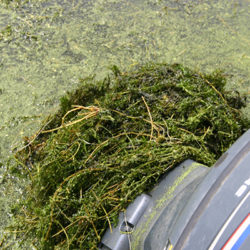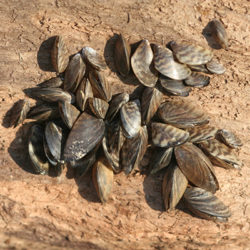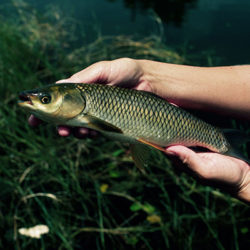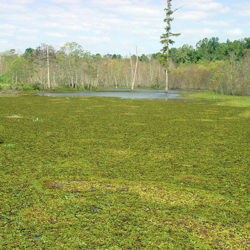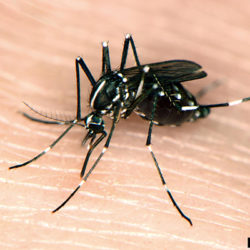I am a Fisherman or Boater. Why should I care about invasive species?
This publication based on: Midwest Invasive Plant Network. 2008. Why should I care about invasive plants? How invasive plants impact hunting, fishing, boating, gardening, hiking, biking, horseback riding, and other recreational activities in the Midwest. From MIPN.org.
Invasive plant and animal species can spread even more quickly through aquatic habitats than they do through terrestrial habitats.
Hydrilla can grow up to eight inches a day in clear water and spreads via tubers, turions, and fragments. Hydrilla can grow to lengths of 25 ft. (7.6 m) and easily becomes tangled in boat propellers. A small fragment of hydrilla left on a boat can be introduced into the next body of water the boat enters. Dense populations of hydrilla shade out native vegetation, raise the pH and temperature of the water while decreasing oxygen levels beneath the mats. This decrease in the quality of the habitat keeps fish smaller and means fewer sport-fish reach harvestable-size. Hydrilla also provides good breeding sites for mosquitoes and interferes with swimming, water skiing, and boating.
Zebra mussels were introduced, accidentally, into the Great Lakes in 1988. Since females can lay more than 100,000 eggs a year, they have spread quickly through several river systems into the South. Mussels pile on top of one another, creating thick “mats” and attach themselves to any hard underwater surface, including boats and docks. When mussels attach to hulls, they increase drag, and may even clog boat cooling systems. They are filter feeders and consume freshwater plankton, thereby decreasing food availability for many other aquatic inhabitants.
Grass carp escaped from a fish farming experiment station in Stuttgart, Arkansas in 1966. Although only sterile fish were authorized for release, populations of grass carp are now known in 45 states, with reproductive populations in the Mississippi, Illinois, Missouri, and Ohio rivers. They have spread quickly with an average female producing 500,000-700,000 eggs over her lifetime. Grass carp can live more than 10 years and can reach 80 pounds or more. Adults have an insatiable appetite and can consume 40-300% of their body weight in plant material every day. Large populations can clear all plant material from a body of water.
Aquatic vegetation provides habitat for juvenile fishes and invertebrates, as well as acting as a stabilizer for bottom sediments. Loss of habitat means juvenile fishes become easy prey for larger animals, reducing the number of fish reaching harvestable size. Eradication of aquatic vegetation stirs sediment into the water and gives algae the opportunity to increase, causing turbid water.
West Nile virus was first detected in the United States in 1999 and is spread by infected Asian tiger mosquitoes. People that spend time around lakes, ponds, or any area with high levels of mosquitoes could be at risk of contracting this virus. Symptoms of the West Nile virus usually range from mild and flu-like to no symptoms at all. However, if the virus enters the brain or spinal cord, death can result. There are still no specific vaccines or treatments available for the virus.
I am a fisherman/boater. What can I do to minimize the introduction and spread of invasive species?
- Remove visible plants, animals, and mud from your boat before leaving a body of water.
- Drain all water from your boat, motor, bilge, live well, and bait containers before leaving water access.
- Dispose of unwanted bait in the trash, and never release plants or animals into a body of water unless they came from that body of water.
- Before entering another body of water, be sure to clean and dry the boat and equipment.

